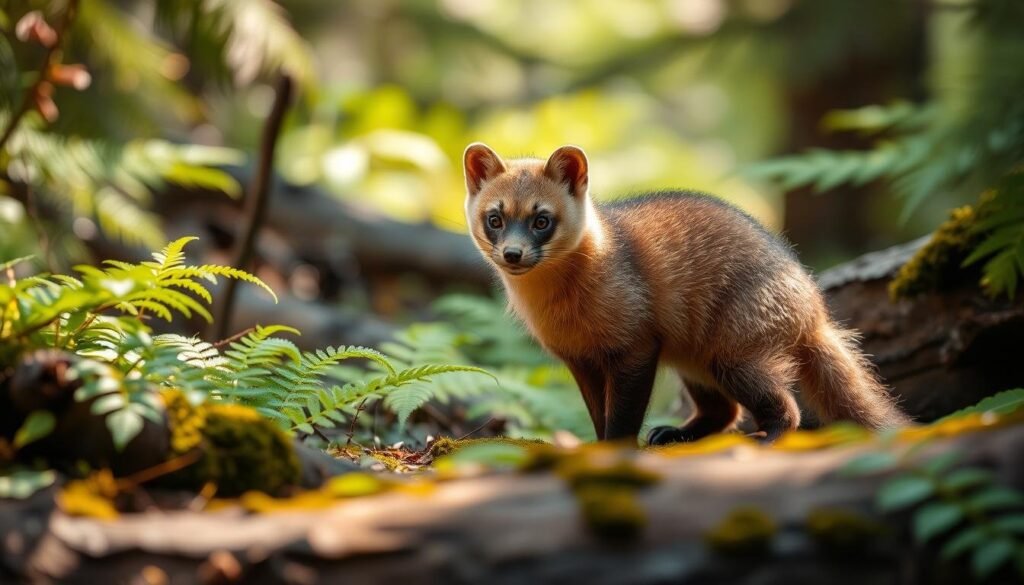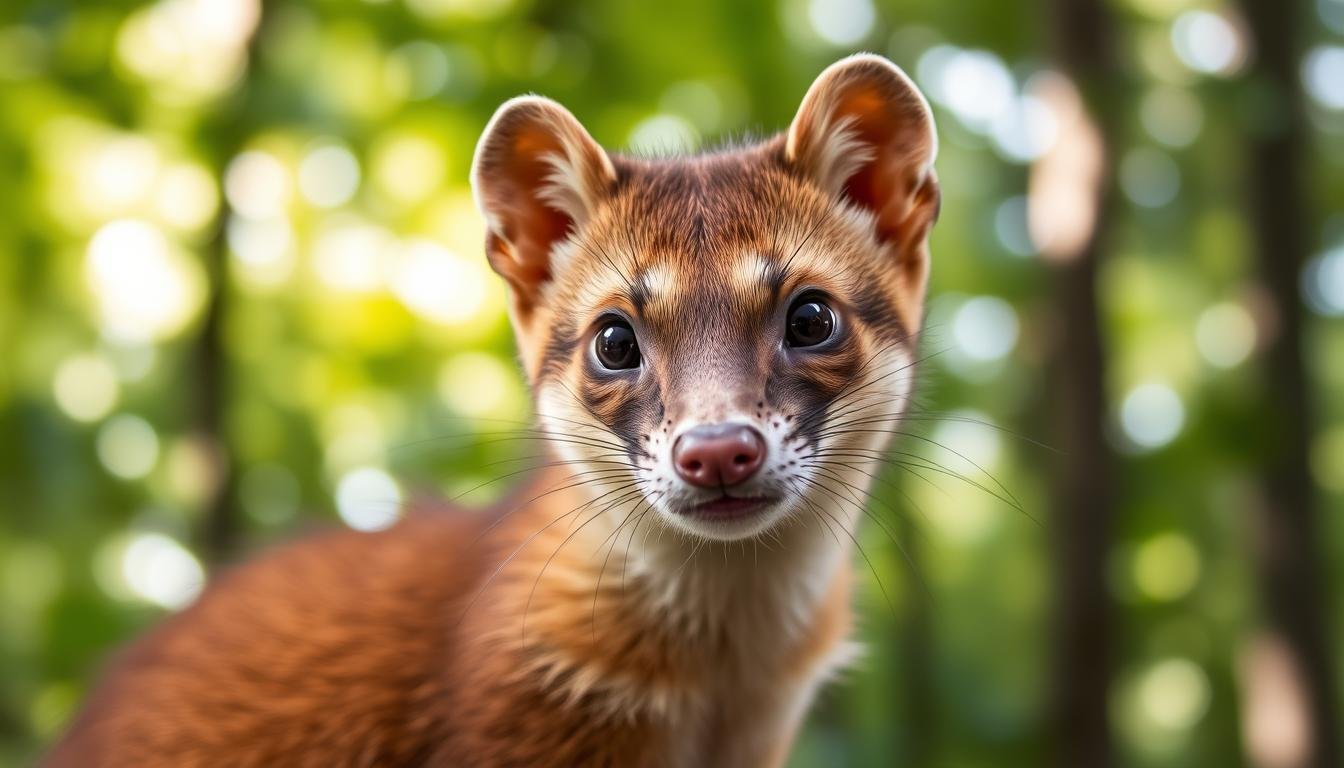Are Pine Martens Dangerous? When you explore the wilderness, you might see many forest creatures. One of these is the pine marten, a fast and nimble animal found in some areas. People often wonder if these animals are dangerous to humans.
It’s important to understand pine martens’ behavior and traits for wildlife safety. Even though they are not usually aggressive, knowing how to safely interact with them is key. In this article, we’ll look at the risks of pine martens and give you tips for safe encounters with these interesting animals.
Contents
Understanding Pine Martens: An Overview
Learning about pine martens can be quite surprising. They are often misunderstood. Knowing more about their characteristics and habits can be very enlightening.
Size, Appearance, and Distinguishing Features
Pine martens are small, weasel-like animals. They have dark brown fur with a yellow-orange bib on their throat. Adults are 20 to 24 inches long, including their tail, and weigh 1.5 to 3.5 pounds.
Their large eyes and sharp claws help them live in trees.
Comparison to Similar Species
Pine martens are sometimes mixed up with fishers or weasels. But, pine martens are slimmer and have bushier tails. They also eat less and live in different places than these animals.
Pine martens live in coniferous forests, often high up. They are found in northern parts of North America, Europe, and Asia. They like places with lots of trees and rocky spots for dens.
Population Trends in the United States
In the U.S., pine martens are mostly found in the Northeast and the Rocky Mountains. Their numbers are steady in these areas. But, habitat loss and climate change could be threats. There are efforts to watch and protect them.
| Region | Population Trend | Primary Habitat |
|---|---|---|
| Northeast | Stable | Coniferous forests |
| Rocky Mountains | Stable | High-elevation coniferous forests |
Why Are Pine Martens Dangerous? Separating Fact from Fiction
It’s important to understand pine marten behavior to know if they’re a danger to humans. These animals are usually alone and hard to find. But, like any wild creature, they can act strangely at times.
Typical Reactions to Human Presence
Pine martens usually run away from people. But, if they’re cornered or feel their babies are in danger, they might not back down.
It’s key to keep your distance to prevent any trouble.
Defensive Behaviors and Triggers
When pine martens feel scared, they might hiss, growl, or show their sharp teeth. Knowing what scares them can help you stay safe.
Encounters between humans and pine martens are rare. Most times, it’s because martens have gotten used to human food or feel trapped.
Risk Assessment Compared to Other Wildlife
Pine martens are not usually a big danger to people. They are less risky than bigger animals.
To avoid problems, make sure to keep food and trash away. This helps keep pine martens from coming near you.
Pine Marten Behavior in the Wild
Pine martens show many interesting behaviors in the wild. These behaviors help them survive and play a key role in their ecosystem. By watching them, we can learn more about their lives.
Diet and Prey Selection
Pine martens eat a variety of foods, including small mammals, birds, insects, and fruits. Their diet changes with the seasons. This flexibility is crucial for their survival.
Their diet is diverse, showing how they make the most of what’s available. This adaptability is a key part of their success.
Hunting Techniques and Activity Patterns
Pine martens are mostly active at night and are great climbers. They use these skills to hunt and avoid predators. Their hunting style is stealthy and shows their agility and keen senses.
They mark their territory with scent glands. This helps them define their space. The size of their territory depends on food and gender, with males having larger areas.
Mating and Family Groups
During mating season, pine martens pair up. The female then has a litter of kits. This time is very important for the family, especially for the mother and her kits.
Learning about these behaviors gives us a deeper understanding of pine martens. It shows their adaptability and the challenges they face in the wild.
Potential Risks to Pets and Livestock
Pine martens are not usually aggressive towards people. But, they can be a big danger to your pets and livestock if you don’t protect them. Since pine martens live near people, it’s important to know the risks and take steps to stay safe.
Risks to Small Pets and Poultry
Small pets like rabbits and guinea pigs, and birds are very vulnerable to pine marten attacks. These animals often live outside in enclosures that pine martens can easily get into.
Documented Cases of Pet Predation
There have been cases where pine martens have attacked domestic pets, especially those left outside. It’s crucial to secure your pets’ enclosures to avoid such attacks.

To keep your pets and livestock safe, make sure their enclosures can’t be broken into by pine martens. Use strong materials and fix any weak spots.
| Securing Method | Description | Effectiveness |
|---|---|---|
| Hardware Cloth | Using hardware cloth around enclosures to prevent chewing through. | High |
| Secure Latches | Installing latches that pine martens cannot open. | High |
| Regular Inspections | Regularly checking enclosures for weak points or damage. | Medium |
Monitoring Pets in Pine Marten Habitats
If you live where pine martens are common, watch your pets closely when they’re outside. Keeping them on a leash or in a safe, fenced area can help avoid pine marten encounters.
By taking these steps, you can greatly lower the risk to your pets and livestock. This way, you can safely live with pine martens in your area.
Safely Coexisting with Pine Martens
Living with pine martens means being aware and taking steps to protect your space. It’s key to know how they act and how to keep your property safe.
Safe Observation Practices
When watching pine martens, stay far away to not scare them. Keep your area clean and without food waste to keep them away.
Response to Aggressive Behavior
If a pine marten acts aggressively, stay calm and slowly move back. Don’t look them in the eye or act in a way that seems threatening.
To keep your homes safe, block any entry points and secure food or bird seed. Using pine marten-proof materials for storage can also help.
Managing Attractants Around Your Property
It’s important to manage what attracts pine martens. Make sure your property has no food waste. Use wildlife-friendly ways to dispose of waste to avoid attracting them.
By following these tips, you can reduce conflicts and enjoy having pine martens around.
Ecological Importance of Pine Martens
Pine martens are very important for forests. They help keep the forest healthy. They play a big role in keeping their ecosystems balanced.
Predator-Prey Relationships and Population Control
Pine martens eat small mammals. This helps control the number of prey animals. It keeps the balance between animals and plants in the forest.
Seed Dispersal and Forest Health
Pine martens also eat fruits. This helps spread seeds. It helps plants grow and makes forests more diverse.
Pine martens face many dangers. These include losing their homes, climate change, and more. These threats make it hard to keep their numbers up.
Conservation Efforts and Success Stories
There are efforts to save pine martens. These include protecting their homes and bringing them back to places they used to live. These efforts are key to keeping pine martens healthy.
| Ecological Role | Description | Impact on Forest Health |
|---|---|---|
| Predator-Prey Control | Regulation of small mammal populations | Prevents overgrazing and maintains vegetation balance |
| Seed Dispersal | Spread of seeds through fruit consumption | Enhances forest regeneration and biodiversity |
Conclusion: Are Pine Martens Dangerous?
Pine martens are not usually a danger to people. They play a key role in forest ecosystems. Learning about their behavior and importance helps us appreciate them more.
It’s important to respect their home and protect pets and livestock. This way, we help conserve these amazing animals and their habitats. As we learn more about pine martens, we understand the need to protect wildlife and live in harmony with nature.
See Also: Why the Korbut Flip is Considered Dangerous in Gymnastics
FAQ
What is the typical diet of a pine marten?
Pine martens eat small mammals, birds, insects, fruits, and nuts. They change what they eat based on the season and what’s available.
Are pine martens aggressive towards humans?
Pine martens usually don’t attack humans unless they’re scared or trapped. They try to stay away from people and run off if they see them.
How can I protect my pets from pine martens?
Keep your pets’ homes safe from pine martens by making sure they can’t get in. Watch your pets when they’re outside, especially where pine martens are common.
What should I do if I encounter a pine marten in my yard?
Stay calm and let the pine marten leave on its own. Don’t stare at it or try to touch it, as this might scare it.
Can pine martens cause damage to my property?
Yes, pine martens might damage your property if they find food or shelter. They could raid bird feeders or pet food. Keep these things safe to avoid problems.
Are pine martens protected by law?
In some places, pine martens are protected because they’re important for the environment. They face threats like losing their homes. Check local laws to see if they’re protected where you live.

Lorenzo Sloan is a safety advocate from Los Angeles who exposes hidden and everyday dangers through research-based blogging. With a background in social work, he aims to keep readers informed, cautious, and prepared for the unexpected risks around them.

